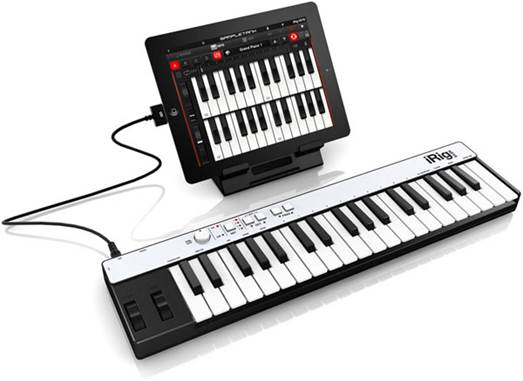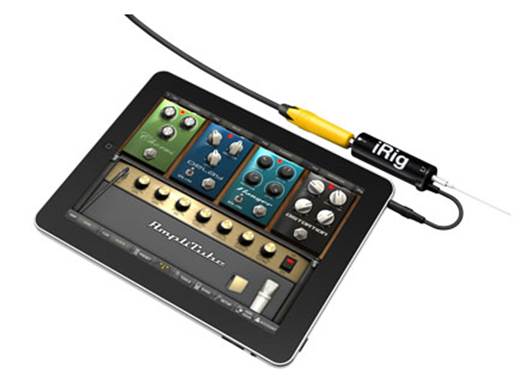Apple users can tricky to please. So
we’ve rounded up some of the most compatible gifts you can give. Or, of course,
receive. Just leave this article strategically placed around the home or office
to be sure of seasonal satisfaction. And do remember to avoid religion,
politics and skeuomorphism at the dinner table
IK Multimedia - iRig KEYS
Price: $90
From: .co.uk
Information: ikmultimedia.com

iRig KEYS is a three-octave (37-key)
keyboard that plugs into Macs, via USB, and iOS devices, via the 30-pin Dock.
If you have a newer device with Lightning, you’ll need Apple’s $38 30-pin
adapter, but then you’ll need it for about a zillion other things as well, so
you might as well bite the bullet and get yourself one.
Designed for portability, the iRig is
powered solely by its data cable, which with a Mac just means there’s no
annoying power cord and adaptor to worry about, but with an iPhone, iPod touch or
iPad means you’ll be draining the battery a little faster than usual while it’s
in use. It doesn’t leach power all the time it’s plugged in, but switches on
automatically when an app is running that’s capable of receiving incoming MIDI
signals. There’s no separate on/off switch. The problem, of course, is that
your iOS device only has one port, so you can’t charge it while the keyboard is
connected; if the battery gets low, you’ll have to stop playing and recharge
before continuing with your composition.
The iRig works well with GarageBand and
other music apps that have MIDI capability. Cheap or free piano apps that just
play sounds from an on-screen keyboard won’t be able to see it, but there are
lots of proper MIDI-aware music apps at all prices. You can also download IK’s
iGrand Piano app, which has free version; we’ll be reviewing this next issue.
Mac users get a copy of SampleTank 2 L, a standalone or plug-in sample player.

The
iRig is best when used in conjunction with GarageBand.
The keys may not be weighted – we wouldn’t
expect that in a keyboard of this size but they are velocity-sensitive. That
doesn’t mean, however, that they have the sensitivity to cope with subtle
classical material: playing quietly requires a lightness of touch that’s almost
impossible to achieve. While you can choose from three different software
settings (light, normal and heavy), the hardware isn’t really up to supporting
a delicate style.
Plenty of other features distract from this
shortcoming. There are separate controls for volume and program changes as well
as the usual pitch and modulation wheels. Pressing both Octave buttons enters
Edit mode, in which the keys themselves can be used to define MIDI channels,
transpose the pitch, set the velocity and so on. There’s a single socket for a
sustain pedal or expression pedal, and four user definable keys that store all
the parameters for the current session. This is particularly useful when
switching between, say, a piano with light velocity sensitivity in a high
register, and a heavier touch and lower octave for s bass part.
At 50x12x3cm, iRig KEYS is compact enough
to fit in an air-line carry-on bag, with no separate power supply to worry
about. The three-octave limitation is eased by up/down octave buttons that can
shift two octaves, although obviously not all at once. If you want to play a
piano piece with left and right-hand parts, you’ll probably need to record them
separately.
The free version of iGrand Piano comes with
three sample pieces of music, including Mozart’s familiar piano sonata K545.
Whether because it was recorded on IK’s own short keyboard or for came other
reason, the top notes in the night-hand part are missing. Not fixing this could
be seen as a kind of honesty, but we have to wonder if they couldn’t have
chosen a different piece.
iRig KEYS is far from being the perfect
keyboard, then, but its compactness and ease of connection make it a great
travel companion. Although lacking in dynamic subtlety, it’s also vastly easier
to play than the on-screen keyboards in GarageBand and other apps, and far more
sensitive than Apple’s gimmicky attempt to simulate velocity sensing using the
accelerometer. It’s a handy accompaniment to almost any decent music app,
making it an ideal present for the Apple-equipped music enthusiast.
Shiny Portable yet playable *Reasonably
priced Dull it’s no Steinway
Native Union - POP Bluetooth
Price: $67
From: nativeunion.com/uk

Created by French designer David Turpin,
the POP Phone is a traditional GPO-style phone handset that connects to your
iPhone for voice calls or to any iOS or OS X device for FaceTime, Skype and
other VoIP services. The latest Bluetooth version works wirelessly, but comes
with a suitably long and curly detachable USB cable for charging. Whether you
want to keep radiation further from your brain, find a phone receiver more
comfortable to hold than an aluminium rectangle, or just like the retro vibe,
it’s an attractive accessory.
It’s also gratifyingly easy to use. There’s
one central button (with plus and minus keys either side); we guessed that
holding this down for a couple of seconds would enable Bluetooth pairing, and
sure enough our iPhone found it immediately. Calling the iPhone then produced a
startlingly loud bell tone from the POP, and clicking the button picked up the
call; clicking again ended it. We then turned down the ring volume using the
minus key.
Clicking the button when not on a call
activates Siri, just like holding the Home button (for obvious reasons, this
will only work if you have no passcode lock, or Settings Passcode Lock Allow
Access When Locked: Siri turned on), so we could voice dial; this will also
work with Voice Control on pre-Siri iPhones.
The POP also worked fine with FaceTime on
both the iPhone and an iPad mini, except that when we received a FaceTime call,
only the device ringtone was activated, not the handsets. Either way, call quality
was very clear. It can’t hurt that the POP’s micro phone points straight at
your mouth.

The
POP also worked fine with FaceTime on both the iPhone and an iPad mini
We’ve seen knock-offs of the POP not only
online but in shops, at a similar price to the original, so if you’re not
buying direct from Native Union, check what you’re getting. The real thing is
precisely made, beautifully balanced, and has a silky silicone texture.
The POP comes with a felt mat to put it
down on, but a matching POP Base ($18) is also available. Or you can choose the
POP Desk instead ($67), which gives you the wired version of the POP, with
curly headphone jack cable, and a metal cradle that holds your iPhone sized for
4/4S at an angle beside the hand-set. The wired POP by itself is also still
available at $37.
Shiny Retro chic *Works well Dull Won’t fit
in your iPhone pocket
Comes in several colors, but red will
fulfill your Cold War brinkmanship fantasies the best